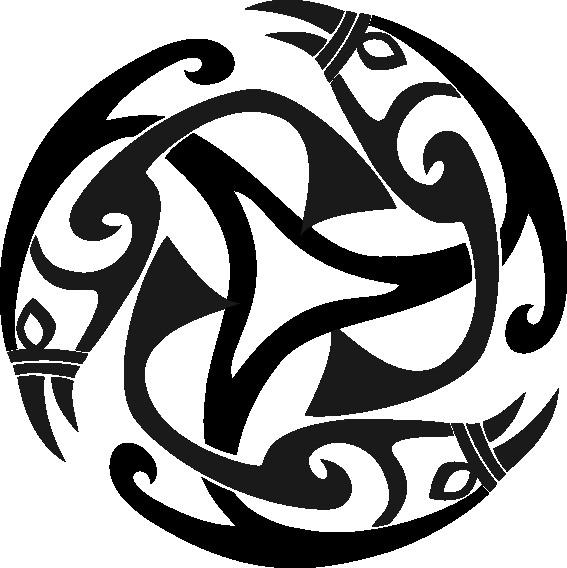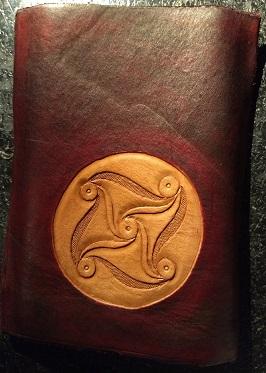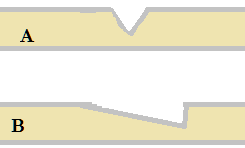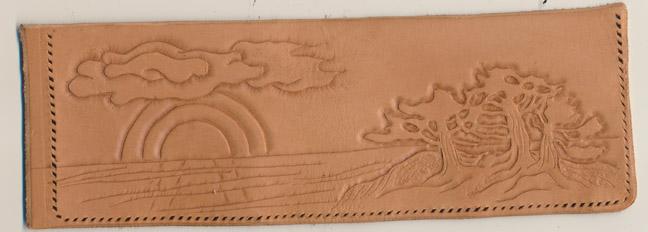-
Posts
1,090 -
Joined
-
Last visited
Content Type
Profiles
Forums
Events
Blogs
Gallery
Everything posted by DJole
-
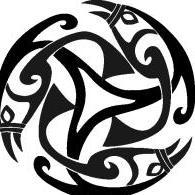
Case for new cellphone
DJole replied to DJole's topic in Purses, Wallets, Belts and Miscellaneous Pocket Items
I thought I would leave it natural, but use a highlighter on it. I haven't done that yet-- I'm still working on the other part.- 4 replies
-
- cell phone
- case
-
(and 2 more)
Tagged with:
-

Case for new cellphone
DJole replied to DJole's topic in Purses, Wallets, Belts and Miscellaneous Pocket Items
Here is the back panel carving, just completed. I am very pleased with myself on this piece of work. That reverse carving background looks great, and I took a lot of care to get the lines evenly spaced. I can see that it's not perfect, but I am still proud of it.- 4 replies
-
- cell phone
- case
-
(and 2 more)
Tagged with:
-

Case for new cellphone
DJole posted a topic in Purses, Wallets, Belts and Miscellaneous Pocket Items
- 4 replies
-
- cell phone
- case
-
(and 2 more)
Tagged with:
-
Maybe a video by Ian Atkinson (of Leodis Leather) which covers this topic will help: https://www.youtube.com/watch?v=zyTg_hfpNUM
-
For starting traditional floral work, you need a set of the following (as listed in Al Stohlman's Leatherwork Manual from 1969): Camouflage, pear shader, beveller, veiner, seeder, and backgrounder. Now the difficult part is figuring out where to go from there, since each of these come in a dizzying variety of sizes (large, small, figure, etc.) and textures (smooth, lined, checked, ribbed, etc.) Since you are learning, you won't need 8 bevellers at the start (4 smooth of different sizes, and 4 checked in different sizes.) Most of us started with the basic set, and then picked up additional tools only as we needed them for a specific project (mulefoot, pebble backgrounder, different border designs, most of the figure carving tools, etc.) As to whether you should go immediately with the Barry King tools... I don't have the expertise to answer that question (or the budget for those Cadillac tools, either!) :-) Perhaps you should spend the money on better knives, rather than carving tools, at the moment. I understand the difference between a cheap swivel knife and a good one can make a lot of difference. And make sure you understand how to correctly case your leather, or else the tools won't work right and your frustration level will rise, as you can't figure out if the problem is you, the knife/tool, or the leather.
-

I was given a huge roll of thick saddle skirting... Need ideas...
DJole replied to EmilyEstelle's topic in How Do I Do That?
Thick leather like that is what a lot of people want to make armor out of. And it's expensive, too. Since that leather was given to you, you could sell it at a bargain price to SCA people in your area, then use that money to buy leather of the thickness you really want. -
Welcome! More voices of experience are always valued, and it's good that the UK contingent keeps growing, too. Ac un Cymro rhagor yw peth da!
-
Not a stupid question at all, since you don't want to spend money on the wrong kind of leather! You also might contact Brettun's Village, up in Maine, to see if they have the dyed veg-tan you need: <https://www.brettunsvillage.com/leather/> I don't work for them (wrong coast!), but they always have a wide variety of leather types and weights, and they might have yours available. Prices and service are fine, too.
-
You can also check out this video, by a resident leatherworker here on the forum, who does some fantastic work:
-
Welcome to the forum and to the world of leatherworking! Here's what I think I see in your bevelling (without getting a closeup view): Letter A is a side view of a beveller used to make a "trough." It's a common problem beginners have as they don't quite understand what the tool is supposed to do. See how there is no "relief", how both sides of the line are equal height? Letter B is what you want-- the beveller is used to push down the leather to make a gradual slope, which fades out away from the design element. This makes the design stand out from the surface of the leather. Want to see it in real life? Take a quick view here: Doing the bevelled lines right will help the antiquing work correctly.
-
It's got to be an optical trick...you found some giant-size tools and put them into the photo, right? Seriously, though... those are TINY lines you did there! I don't know how you pulled it off, but you did. That would be a difficult how-to video to make, since the movements would be so small. I have a couple designs I have shelved simply because they have some very, very small and narrow lines, and I just don't want to mess with them yet. I'm considering laser engraving instead.
-
So true!
-
That's a pretty good start! Just remember, you don't NEED to buy ALL the tools, and certainly not all at once! Here's a handy set of videos from Ian Atkinson at Leodis Leather (website = http://www.ianatkinson.net/leather/videos.htm) that might help your wallet out: Beginners’ Videos Top 25 Recommended Leatherwork Tools (45 mins) The Tools You Need for Leatherwork (15 mins) The Hardware You Need for Leatherwork (30 mins) Information About Dyeing Leather (45 mins) Choosing the right type, weight and quality of leather for your projects (35 mins) Hand Stitching Leather (1 hour 35 mins)
-
Horse legs-- a whimsical touch to the piece, for sure! Do you have any oblique or front-on photos, rather than just the side photos?
-
I have a selection of pre-waxed linen thread when I want to try for historical accuracy (i.e. medieval Europe) for certain pieces. It's also an aesthetic thing -- stitching with natural materials vs. plastic. There is nothing wrong with nylon thread-- I have some of that, too, and I do use it for certain projects! I get my linen thread from Royalwood Ltd., a basketry/ beading supply store in Ohio which also happens to sell a large variety of Irish linen thread, in a large selection of colors and plies (2 up to 12 ply, if I remember right). The waxed linen thread wears well -- I had to re-do a few stitches on my wallet (red linen thread) because a row of 5 stitches on the top edge had worn out after 6-7 years of constant surface wear. All the other stitches, set down in grooves in the leather, are still looking good. With the linen thread, I can take a piece of 5 ply and turn into a set of 2 and 3 ply, each re-twisted, so I can tailor the thread size to the stitch length. I find that when stitching with linen thread I have to pay attention with the needles, since it's very easy to push the needle through the thread instead of to the side. (I find braided thread doesn't do that nearly as much.)
-
Taking a quick look at Amazon, the stitching ponies that come up for sale under that search term are identical to the one I use (I picked mine up at a shop in Seoul, Korea, but it's the same.) Here are the things I find acceptable: 1) Cam lock is nice -- quick and easy to operate, unlike the wing-nut closing type. I also don't find myself getting my thread caught in it (which seems to be a common problem with the wing-nut type.) and if the cam goes bad, I know I can quickly and easily get a replacement cam lock (I checked online.) 2) portable and adjustable -- I can turn the piece for best viewing, and lean it under my leg to give it that tilt which most stitching horses have. Stitching clams do things differently, of course. 3) pretty solid clamping, especially after covering the jaw surfaces with leather to protect the work. 4) If I want to, I can leave the work in the jaws and walk away from it. The leg-closed clams work differently, of course. 5) If you are doing belts, perhaps a longer jaw (longer than the 2 inches) would really be useful. For the price, these will help you improve and speed up your stitching, and should be quite durable. And if you find you really want other features, you didn't waste a lot of money to find that out! There certainly may be much nicer options out there, but these should be nice for starting out.
-
The style of stitching clam/pony/horse is a complicated problem. The best solution would be to go try different kinds and see which features you like the best, but that's going to be hard to do-- you've got people living nearby who have all the types? Then you are a lucky leatherworker! So are you wondering whether to get a European style stitching clam, or a stitching pony?
-
My tooling slab was a free piece of granite scrap. The counter makers wondered why I wanted a broken piece of granite, but it meant they didn't have to take it away. it has a nice smooth surface and a curved edge. White marble might be sexier, but my stone was free.
-
-

Sunset wallet
DJole replied to DJole's topic in Purses, Wallets, Belts and Miscellaneous Pocket Items
Yes, you are correct. I realized this *after* I made the stitching holes, but no harm done! I will be leaving the "gap" in the middle open, so the stitching along that part of the edge will not close the pieces together. Important safety tip, wallet makers! -
This is my current project-- a wallet with a landscape. The tooling on the outside piece is done, and the stitching holes made (3mm) with my nice JapanGoods chisel set. I made the left side deliberately too long, so that when I get it all stitched up, I can trim that edge to the correct size. I like the trees here -- the undercut beveller really made the silhouette pop. Right now I'm working on the interior pockets. More to come as it is completed.
-
A co-worker of mine found out that I did leatherwork, and she thought a neat father's day present for her son would be a wallet with her grandson's handprint tooled onto it. I thought about it and it sounded like a possible thing. Has anybody done something like this before?
-

Leatherman Case
DJole replied to dfrensdorff's topic in Gun Holsters, Rifle Slings and Knife Sheathes
A lovely home for a great tool to have on you! That is some excellent, deep basket weave there.


